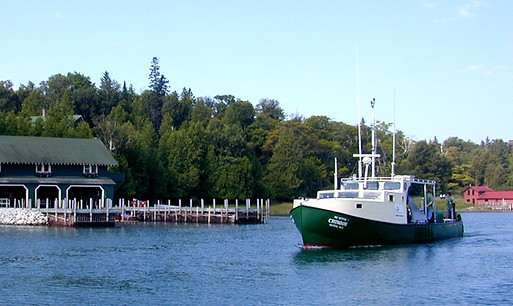Chinook




In 2016, the Michigan Department of Natural Resources Fisheries Division donated their Lake Huron fisheries research/assessment vessel to Besser Museum. The Research Vessel Chinook, was built for the Michigan Department of Conservation (now the Department of Natural Resources) Law Enforcement Division in 1947, was transferred in 1968 to the Fisheries Division for its research program, and was retired in 2016, after nearly 70 years of service.
After 21 years of enforcing commercial fishing laws on the Great Lakes, the Chinook was used by the Fisheries Division, Alpena Fisheries Research Station, to monitor trends and the effects of invasive species on important fisheries in Lake Huron and the St. Marys River. A typical sampling season could see the Chinook working anywhere between the Sault Locks in the Upper Peninsula, to Lexington at the south end of Lake Huron. Probably the most important projects were measuring the impacts of sea lampreys on lake trout recovery, monitoring lake trout population dynamics and trends, documenting the recovery of walleye in Saginaw Bay, prey consumption by upper trophic levels (meaning top predators such as lake trout, salmon, and walleye), and the rise and collapse of the Chinook salmon population.
The Chinook’s career on Lake Huron spanned a period of ecosystem perturbations including collapse of keystone predators (lake trout and walleye), control of the invasive, parasitic sea lamprey, restocking of top predators, assertion of tribal fishing rights, enhanced commercial and recreational harvest management, and invasion by dreissenid mussels and round gobies. An interesting chapter of the RV Chinook’s career was when she was rigged for salmon trolling and used to measure salmon distribution (including in Canadian waters) and develop methods for offshore troll fishing for salmon.
Key transitions during the Research Vessel Chinook’s data collections were improved control over the sea lamprey population, collapse of alewives (an invasive species and preferred prey of Chinook salmon) and, shortly thereafter, the Chinook salmon population collapse; the recent full recovery of walleye, and the ongoing recovery of a self-sustaining lake trout fishery in Michigan waters of Lake Huron. The RV Chinook also documented recovery of lake whitefish in Lake Huron during the 1970s and 1980s and the recent decline in whitefish reproduction and growth in Thunder Bay.
Data collected aboard the Chinook have contributed to many manuscripts in scientific journals and have thus helped inform the Great Lakes science community of these and recent lower foodweb changes. Sharing this information with a broader lay audience is a goal of the Besser Fisheries Heritage Project and will be a leading role of the RV Chinook in her new career at the Besser Museum. To this end, key data sets spanning the period of sea lamprey control and lake trout recovery will be provided by the DNR’s Fishery Division and Hammond Bay Biological Station/Great Lakes Fishery Commission.
Using these data, students will be able to do their own analyses to, for example, see whether sea lamprey wounding on lake trout changed with lamprey control improvements and whether the RV Chinook’s catches of mature lake trout improved over time. Or when did walleye recover to become self-sustaining in Lake Huron, and what seems to explain the return of walleye? Using video taken aboard the Chinook in 2007-2008, visitors will be able to experience what it was like to work aboard the Chinook during this exciting era of Lake Huron’s dynamic fisheries.
Invaders of the Great Lakes (Filmed on the Chinook)
"I felt this was a story that needed to be shared with the people of Michigan, of the Great Lakes region, and with all who cherish these amazing freshwater resources," said Jim Johnson, a research biologist and manager of the Michigan Department of Natural Resources Alpena Fishery Research Station.
Directed by GVSU professor John Schmit, this Emmy-nominated documentary tells the history of exotic species invasions in Lake Huron and describes other invaders looming on the horizon. Biologists from around the Great Lakes describe the invaders, the damage they have caused, and efforts to manage Lake Huron's ecosystem and multi-million dollar fisheries.








